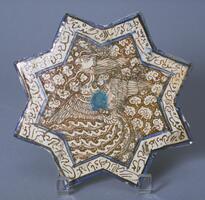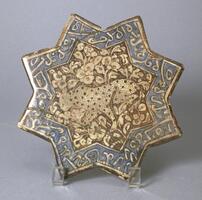29 UMMA Objects
29 UMMA Objects
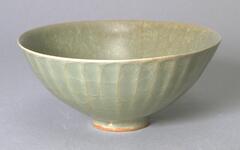
Chinese (Chinese (culture or style))
Bowl
13th century
Museum purchase for the James Marshall Plumer Memorial Collection
1964/2.73
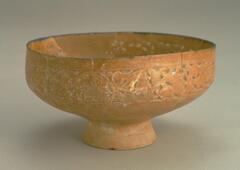
Iranian (Iranian)
Footed Bowl with openwork floral scroll design
1167 – 1232
Museum Purchase
1957/1.61
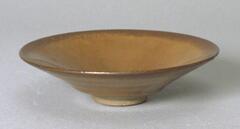
Chinese (Chinese (culture or style))
Teabowl
13th century
Gift of Mr. and Mrs. Arno L. Bader for The James Marshall Memorial Collection
1965/2.56

Chinese (Chinese (culture or style))
Jian Ware "Hare's Fur" Teabowl
1100 – 1299
Gift of Mr. and Mrs. Stephen H. Spurr
2003/2.19
![<p>This octagonal dish is inlaid with a chrysanthemum design with white and black slip on each facet. Its outer base is entirely glazed and has three quartzite spur marks. The inner surface is undecorated but covered in crackles, revealing the gray body. The glaze was oxidized during ring, leaving many areas brown.<br />
[<em>Korean Collection, University of Michigan Museum of Art </em>(2014) p.117]<br />
</p>
<p>This octagonal dish is inlaid with a chrysanthemum design with white and black slip on each facet. Its outer base is entirely glazed and has three quartzite spur marks. The inner surface is undecorated but covered in crackles, revealing the gray body. The glaze was oxidized during ring, leaving many areas brown.<br />
[<em>Korean Collection, University of Michigan Museum of Art </em>(2014) p.117]<br />
</p>](/media/W1siZiIsIjIwMjIvMDkvMjQvNHVpbG92a2E1bl9kZWZhdWx0LmpwZyJdLFsicCIsInRodW1iIiwiMjQweDIwMCJdXQ?sha=811709a388c3f99f)
Korean (Korean (culture or style))
Octagonal faceted bowl with inlaid design of paired chrysanthemums on outer side
1250 – 1350
Gift of Bruce and Inta Hasenkamp and Museum purchase made possible by Elder and Mrs. Sang-Yong Nam
2004/1.234
![<p>The lid of this jar is carved with lotus petal design, crowned with the knob shaped as a lotus bud. Three refractory spurs are stuck to the inside of the lid. The shoulder of the jar is decorated with a descending willow design inlaid with white slip. The entire foot and outer base are glazed, but it is poorly fused and rough with impurities stuck to it. The lid retains a celadon color, but the jar itself is a light gray hue overall.<br />
[<em>Korean Collection, University of Michigan Museum of Art </em>(2014) p.134]</p>
<p>The lid of this jar is carved with lotus petal design, crowned with the knob shaped as a lotus bud. Three refractory spurs are stuck to the inside of the lid. The shoulder of the jar is decorated with a descending willow design inlaid with white slip. The entire foot and outer base are glazed, but it is poorly fused and rough with impurities stuck to it. The lid retains a celadon color, but the jar itself is a light gray hue overall.<br />
[<em>Korean Collection, University of Michigan Museum of Art </em>(2014) p.134]</p>](/media/W1siZiIsIjIwMjIvMDkvMjQvN2FsdDhlMjE5eV9kZWZhdWx0LmpwZyJdLFsicCIsInRodW1iIiwiMjQweDIwMCJdXQ?sha=e14cf9abceae9ee5)
Korean (Korean (culture or style))
Covered Cosmetic Jar
1167 – 1232
Gift of Bruce and Inta Hasenkamp and Museum purchase made possible by Elder and Mrs. Sang-Yong Nam
2004/1.243A&B

Chinese (Chinese (culture or style))
Returning Herder and Water Buffalo, After Rain
13th century
Museum purchase made possible by the Margaret Watson Parker Art Collection Fund
1965/2.70
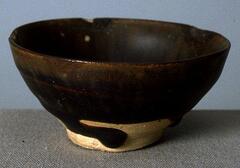
Chinese (Chinese (culture or style))
Teabowl
13th century
The James Marshall Plumer Memorial Collection
1983/1.445

Syrian
Prayer Book of Service for the Dead, manuscript page
1267 – 1299
Gift of Mr. and Mrs. Milton B. Freudenheim in memory of Otto F. Ege
1987/1.195.3
Loading…
